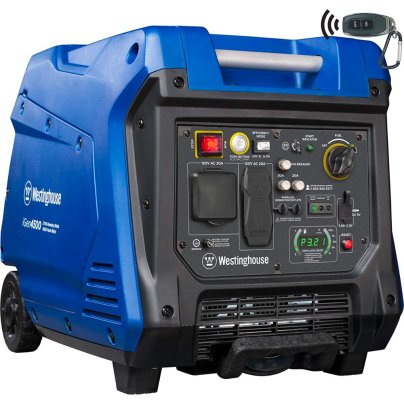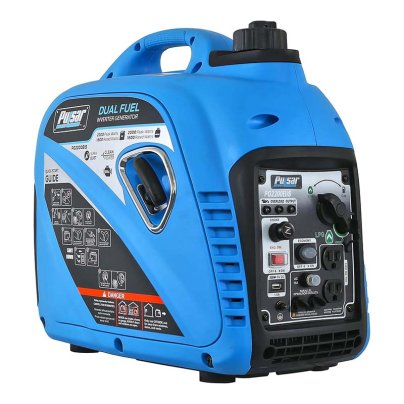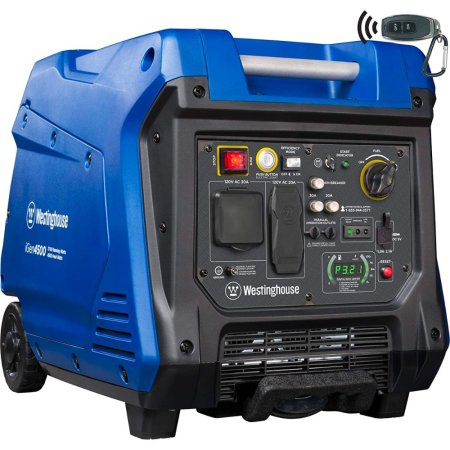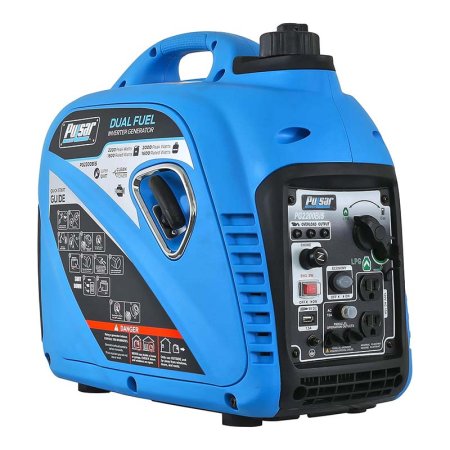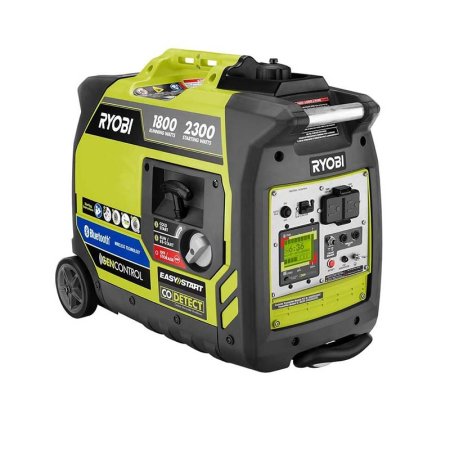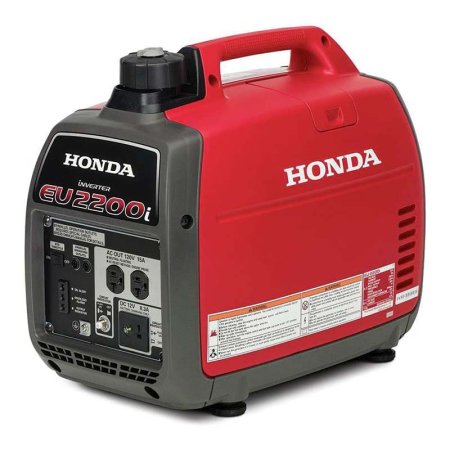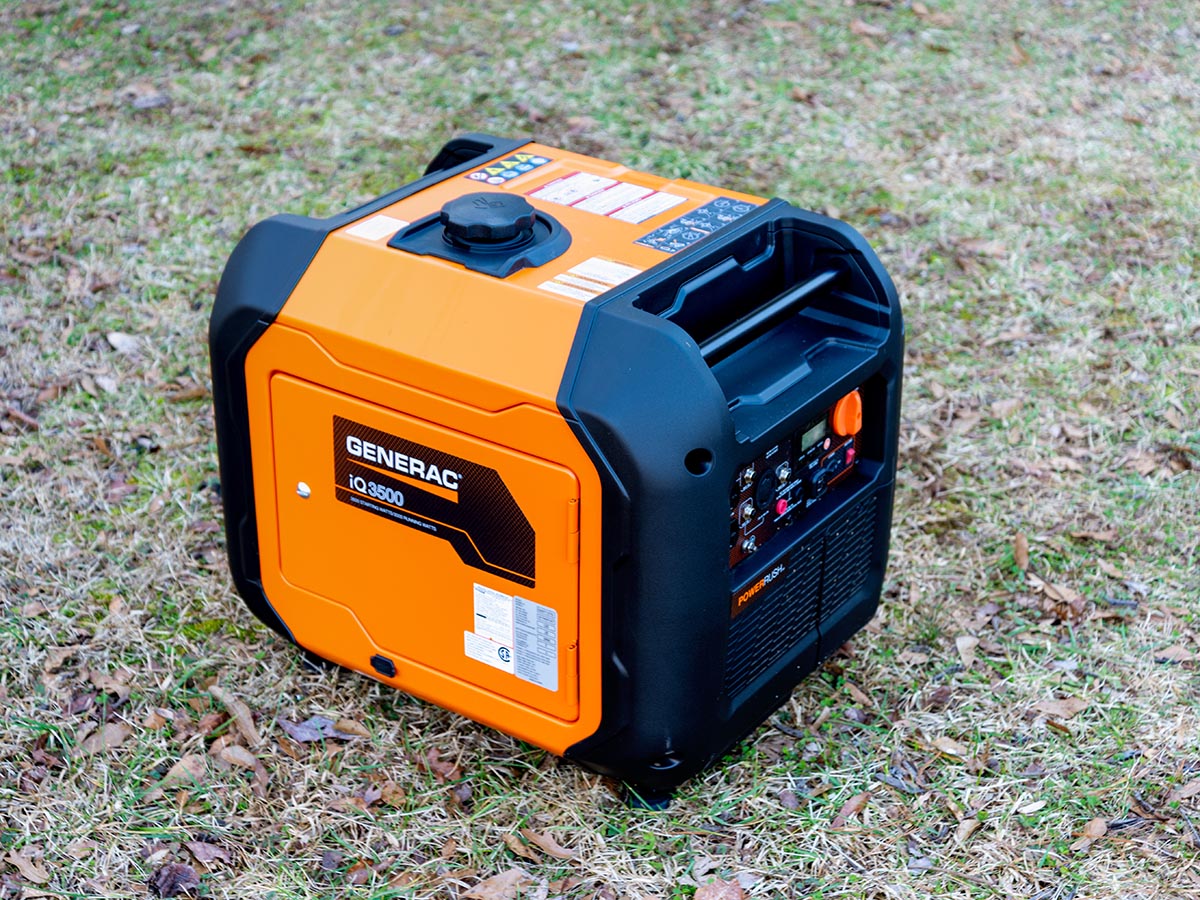
We may earn revenue from the products available on this page and participate in affiliate programs. Learn More ›

Prime Day Deal Extended
Amazon’s Prime Big Deal Days may be over but our Best Bang for the Buck option, the Pulsar 2,200W Dual-Fuel Inverter Generator is still on sale for $420 (save 40%). Hurry, this deal won’t last long!
Portable generators are crucial during power outages and helpful for remote locations, and inverter generators are the crème de la crème in terms of efficiency.
Similar to traditional models, inverter generators come in different sizes and outputs, but they use a computer-controlled inverter to provide usable power as needed. This makes them lighter, quieter, and more efficient than traditional open-framed generators, which supply a set amount of power regardless of current needs.
Inverters are still relatively new generators on the market, so we wanted to test the bestselling models before making recommendations to our readers. The Bob Vila test team put several brand-name inverter generators to the test at their homes to see how they performed. Our favorite was the Westinghouse iGen4500 Inverter Generator for its incredible portability, efficiency, and handy remote.
Keep reading to learn what sets these generators apart from traditional models and how they fared in our hands-on tests. Our top picks vary in output and intended use, and they are all worthy of their spot in our lineup of the best inverter generators.
- BEST OVERALL: Westinghouse iGen4500 Inverter Generator
- BEST BANG FOR THE BUCK: Pulsar 2200-Watt Dual-Fuel Quiet Inverter Generator
- BEST CARB-COMPLIANT: Generac iQ3500 Portable Inverter Generator
- BEST BLUETOOTH: Ryobi 2300-Watt Bluetooth Inverter Generator
- BEST DUAL-FUEL: Champion 2000-Watt Dual-Fuel Inverter Generator
- BEST SMALL: Honda 2200-Watt Inverter Generator With CO-Minder
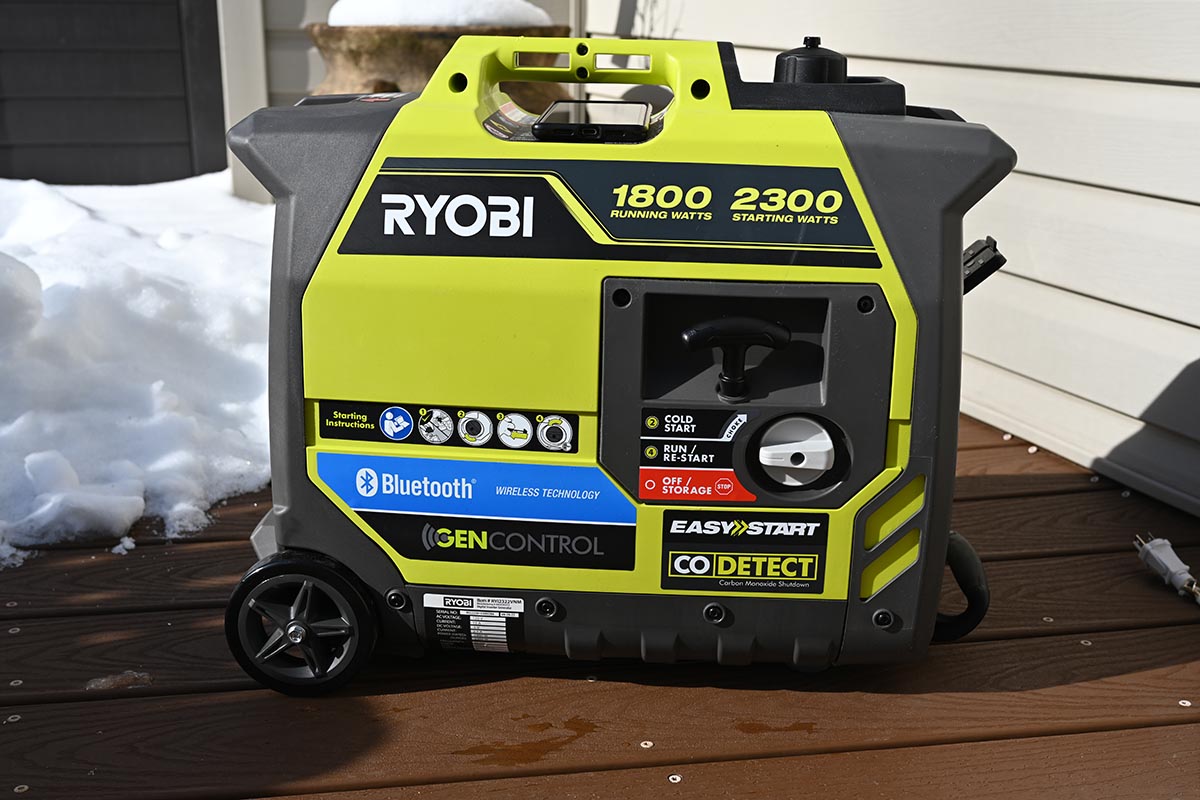
How We Tested the Best Inverter Generators
We researched over 25 different makes and models of inverter generators before selecting several top options for testing. When compiling this list, we considered brands like Champion and Honda since they’re well respected in the generator industry. However, we didn’t automatically cut machines from smaller companies like Wen and Ryobi if they had good features and high customer satisfaction ratings.
For our real-life tests, we assembled the generators and followed the manufacturer’s instructions for fueling and operation. We tried to max out each generator, estimating how many items we could plug in using an online wattage calculator. We powered tools, appliances, heaters, mini AC units, and more, noting how to use the generators and how much noise they emitted when running.
After testing, we awarded each inverter generator points based on a rubric. We assigned them ratings for ease of use, noise, power, portability, and value.
A note on noise level ratings: Many generators are inherently loud. Therefore, we scored each generator’s noise on whether it matched the expected levels set forth by the manufacturer and what would be reasonable given the machine’s wattage. If it was louder than expected, we rated it lower. If it was quieter, we rated it higher.
Testing Stats
Products tested: 7
Hours spent testing: 40.5
Tests performed: 5
Average price: $772
Our Top Picks
The following inverter generators represent some of the best generators currently available. Each one earned its spot by performing well in our hands-on tests. Whatever your power needs may be, there’s likely to be a generator on this list that’ll hit the mark.
Best Overall
Westinghouse iGen4500 Inverter Generator
Product Specs
- Wattage: 4,500 peak watts and 3,700 running watts
- Fuel: Gasoline
- Outlets/ports: One 120 volt (V)-30 amp (A) outlet; two 120V-20A outlets; 2 USB-A ports
- Weight: 104.7 pounds
Our Ratings: Ease of Use 5/5; Noise 4/5; Portability 4/5; Power 4.5/5; Value 4.5/5
What We Like
- Remote control offers starting and stopping from a distance
- Eco mode saves energy when power draw is minimal
- Extendable handle and wheels make it easy for just 1 person to move
What We Don’t Like
- Not dual fuel; runs on gasoline only with no option for propane
Westinghouse’s iGen4500 inverter generator is both a high-tech and high-functioning model. It offers a variety of power ports, including a 30A, two 20A, and two USB. In our tests, we used it to charge our digital devices while also powering the appliances in our travel trailer. The iGen4500 has a 3.4-gallon gasoline tank that can run up to 18 hours. As an inverter generator, it only burns as much fuel as needed to power the appliances or tools plugged in. This makes it more eco-friendly than a noninverter model that burns fuel at a set rate no matter how much power is being drawn.
However, with a weight of almost 105 pounds without fuel, we found it challenging for one person to lift it into and out of our truck bed. Once on site, its setup was simple: We added oil, filled the gas tank, and were in business. While this would be a great emergency generator, its quiet and efficient operation makes it a top-notch pick for RVs, camping, and remote powering.
Read our full review: Westinghouse iGen4500 Inverter Generator
Get the Westinghouse inverter generator at Amazon.
Best Bang for the Buck
Pulsar 2200-Watt Dual-Fuel Quiet Inverter Generator
Product Specs
- Wattage: Gasoline: 2,200 peak watts and 1,800 running watts; propane: 2,000 peak watts and 1,600 running watts
- Fuel: Gasoline or propane
- Outlets/ports: Two 120V-15A AC outlets; 1 USB-A port
- Weight: 46.5 pounds
Our Ratings: Ease of Use 4/5; Noise 4/5; Portability 5/5; Power 4.5/5; Value 4.5/5
What We Like
- Light enough to move around without strain
- Easy to set up and get the engine running
- Ability to run on either propane or gasoline increases versatility
What We Don’t Like
- Access panel to change the oil was difficult to remove
- Changing the oil required tipping the generator on its side
The Pulsar 2200-watt inverter generator is a great option for powering small tools and devices at home or on the jobsite. The generator uses gasoline or propane and supplies up to 1,800 running watts with gas and 1,600 with propane.
During our tests, we found the initial setup of the generator to be easy, except for filling the oil for the first time. The fill port sits under a side panel we had to remove to gain access. Unscrewing the panel was easy enough, but it took some budging to get it to pop off completely. After that, filling it up with the supplied Pulsar-brand oil was straightforward.
The engine’s recoil start requires just a couple of pulls before the engine kicks on with 2,200 watts (using gas) of startup power. To test the generator’s capabilities, we ran a couple of heat guns and hair dryers simultaneously, using different combinations of high and low settings to test it at different loads. We found the generator easily handled the necessary output, but it seemed to produce more than the advertised 59 decibels, which is about the level of conversation. The Pulsar sounded a bit louder, more like a vacuum, though that’s about the sound level we’d expect from a generator of its size.
Despite the slight sound issue, we like this generator for light-duty needs, such as small DIY projects and powering a couple of household appliances during an outage.
Get the Pulsar inverter generator at Amazon or Walmart.
Best Carb-Compliant
Generac iQ3500 Portable Inverter Generator
Product Specs
- Wattage: 3,500 peak watts and 3,000 running watts
- Fuel: Gasoline
- Outlets/ports: Two 120V-20A outlets; one 120V-30A outlet; 2 USB-A ports
- Weight: 109.1 pounds
Our Ratings: Ease of Use 4/5; Noise 4/5; Portability 3/5; Power 4.5/5; Value 4.5/5
What We Like
- Easy and reliable startup via a push-button starter and pull-cord backup
- Eco-mode for fuel-efficient idle; automatically increases output when the need arises
- LCD displays output, runtime, and fuel level status in real time
- Parallel ready; 2 iQ3500 generators can be combined for twice the power
What We Don’t Like
- Though well made and versatile, it is expensive compared to similar models
- Weighs more than 100 pounds but does not include wheels to aid transport
When it comes to clean electricity, inverter generators provide a stable current free of voltage spikes and drops. But, not all inverters are “clean” in terms of their impact on air quality. The Generac iQ3500 inverter generator offers the best of both worlds. As a California Air Resources Board (CARB)-compliant inverter generator, it safely and quietly powers sensitive electronic devices while consuming less fuel and emitting less pollution. It comes equipped with a locking 30A outlet, a 20A duplex outlet, and two USB ports to power a wide range of tools and appliances.
Two premium features that set it apart include a large LCD screen that displays power output and fuel levels and a push-button ignition switch. The unit’s 20A duplex receptacle gave it more flexibility for powering high-draw tools and appliances than the 15A alternative on other inverter generators. We used it to power two 1,500-watt space heaters simultaneously for over an hour without tripping the breaker. To test the 30A outlet, we used a three-way service cord to supply a portable table saw, miter saw, and router. Everything worked as smoothly as if plugged into the wall at the shop.
The iQ3500 had a lot of strong points, but easy transport was not one of them. It weighs 109.1 pounds and doesn’t have wheels. Yet this was still one of the all-around favorites for its easy startup, quiet operation, and convenient access to electricity.
Get the Generac inverter generator at Amazon, Tractor Supply Co., Walmart, or Generac.
Best Bluetooth
Ryobi 2300-Watt Bluetooth Inverter Generator
Product Specs
- Wattage: 2,300 peak watts and 1,800 running watts
- Fuel: Gasoline
- Outlets/ports: Two 120V-20A outlets; 2 USB-A ports
- Weight: 52 pounds
Our Ratings: Ease of Use 5/5; Noise 4/5; Portability 4/5; Power 4/5; Value 5/5
What We Like
- Fast and easy to assemble; takes under 10 minutes and has no complicated steps
- Convenient monitoring of the generator’s status from a distance via Bluetooth technology
- Powers a range of tools, small appliances, and digital devices
What We Don’t Like
- Not suitable for powering wattage-hungry appliances such as heat presses
The Ryobi 2,300-watt gas generator was a pleasure to test. Unboxing to startup took under 10 minutes, and the app walks users through the process while showing the same readings as the machine’s LED panel. For our tests, we plugged in several work lights and used various power tools, including a circular saw, a reciprocating saw, a jigsaw, a hammer drill, and a sander. The Ryobi lagged a bit when we tried to run a table saw, and it didn’t provide enough juice for a heated t-shirt press, but otherwise, it met our needs. We liked the convenience of being able to monitor the status of the Ryobi while sitting comfortably indoors. We were able to shut down the generator from the app but not start it, which is probably a smart idea in terms of safety.
The Ryobi is relatively quiet, registering 57 decibels from 10 feet away, and we could converse easily without raising our voices. This little generator would be an excellent pick for craft festivals and tailgating excursions. It won’t power a jobsite or all appliances in a home, but it’s perfect for smaller-power uses.
Get the Ryobi inverter generator at The Home Depot.
Best Dual-Fuel
Champion 2000-Watt Dual-Fuel Inverter Generator
Product Specs
- Wattage: Gasoline: 2,000 peak watts and 1,700 running watts; propane: 2,000 peak watts and 1,530 running watts
- Fuel: Gasoline or propane
- Outlets/ports: Two 120V-20A outlets; one 12V DC outlet
- Weight: 39 pounds
Our Ratings: Ease of Use 4.5/5; Noise 4/5; Portability 4/5; Power 4.5/5; Value 4.5/5
What We Like
- Dual-fuel ability allows the generator to run on gasoline or propane
- Compact design makes it easy to transport for camping or tailgating
- Runs quietly, making it a good pick for areas where noise pollution is a concern
- Lightweight for a dual-fuel model, making it an excellent choice to transport for remote use
What We Don’t Like
- Relatively small tank (1.05 gallons) will require frequent filling if running at full load
- At 1,700 running watts, it won’t handle more than 1 or 2 major appliances at a time
Despite being one of the more compact inverters we tested, the Champion Power Equipment 2,000-watt generator excelled. It comes with dual-fuel ability, meaning we could run it on either gasoline or propane. This makes it highly versatile when one fuel type is preferred. The Champion produces up to 2,000 surge watts on startup and settles into a respectable 1,700 watts using gas. It has two standard outlets and a 12V car-type port. The generator’s gas tank is on the small side at 1.05 gallons, but it will run for 11.5 hours when pulling a 25 percent load. Connecting a 20-pound propane tank and pulling the same load will run up to 34 hours.
During testing, we used the Champion to run several appliances, including a coffee maker and a blender. However, when we tried to run all the items simultaneously, we overloaded the machine, and the safety shutoff kicked in and shut it down. Of course, that will happen with any generator if it’s overloaded.
One great thing about this dual-fuel generator is how quietly it runs. The manufacturer claims it creates only 53 decibels of noise, which we found to be accurate in our tests. It’s also relatively lightweight for a dual-fuel model at just 39 pounds, but it won’t be able to run all appliances in an outage. Still, it will power a few and keep electronic devices charged without creating a ruckus.
Get the Champion inverter generator at Amazon or Walmart.
Best Small
Honda 2200-Watt Inverter Generator With CO-Minder
Product Specs
- Wattage: 2,200 peak watts and 1,800 running watts
- Fuel: Gasoline
- Outlets/ports: Two 125V-20A outlets
- Weight: 47.4 pounds
Our Ratings: Ease of Use 5/5; Noise 4/5; Portability 4/5; Power 5/5; Value 4/5
What We Like
- Lightweight construction and compact build for easy storage and transportation
- Whisper-quiet operation keeps the lights on without disturbing the neighbors
- Compatible with the Honda My Generator mobile app for remote monitoring
- CO-Minder advanced carbon monoxide detection and emergency shutoff system
- Powered by a reliable Honda GXR120 commercial series engine
What We Don’t Like
- Premium price point for less total output than other tested options
- Not equipped with USB ports; less convenient for small electronic devices
The Honda EU2200i inverter generator features a Honda GXR120 commercial series 121 cubic centimeter engine with a recoil starter. It generates 120 volts; up to 1,800 running watts (15A); and 2,200 peak watts. Its 0.95-gallon gas tank provides up to 3.2 hours on maximum draw or up to 8.1 hours with a 25 percent output load. This compact, quiet generator is convenient for tailgating, camping, and other remote power needs.
The Honda’s lightweight, compact build made it comfortably portable. The top handle and suitcaselike shape were good for one-handed transport. At about 48 pounds, we wouldn’t want to carry it all day, but moving it from the shed to the truck was no problem. Roller wheels would have been a nice addition. Frequent users could purchase a collapsible hand truck for easier mobility.
The simple output configuration of just one 15A 120V duplex outlet allowed us to use it like any household wall socket without worrying about overloading it. We powered a portable table saw and miter saw on one project, then a refrigerator (alone) for a few hours to see how it would respond. Everything worked perfectly. Since it doesn’t have USB ports, you’ll need a wall hub or power strip to charge devices or power up small electronics.
Get the Honda inverter generator at Amazon, Lowe’s, The Home Depot, or Northern Tool + Equipment.
Jump to Our Top Picks
What to Consider When Choosing an Inverter Generator
Inverter generators are a different breed than the open-framed conventional generators most people are familiar with. While both use fuel (gasoline, diesel, or propane), open-framed generators use an alternator to make usable power for homes, campers, and jobsites. The info below will help narrow down the options to find the best generator deals on units with the power, portability, and convenience you need.
Wattage
Wattage is a critical factor in any generator specification. Inverter generators, like their open-framed counterparts, come in different wattage ratings. The higher the wattage rating, the higher the power output. Higher wattages usually mean larger, more expensive units, so here’s a guide to choosing the right size for a range of needs:
- Light-duty (tent camping, tailgating, etc.): 2,000 to 3,000 watts
- Medium-duty (RV camping, emergency home use, jobsite, etc.): 3,000 to 4,500 watts
- Heavy-duty (powering an entire home, powering a welder, etc.): 4,500+ watts
Compact, portable generators may be feasible for powering a radio or a small refrigerator. However, there is often less flexibility for plugging in other devices with a low-wattage model. Keep in mind that an inverter generator only supplies as much power as necessary. It doesn’t generate energy if it’s not being pulled, making this generator more of a clean power source.
Fuel Type and Capacity
Inverter generators typically use gasoline as a fuel source, but dual-fuel generators can run on propane as well. This is a big advantage, as it allows owners to choose the fuel used based on their needs, such as power-output requirements, fuel availability in the area, and the fuel type currently on hand.
Inverter generators have an isolated gasoline tank with a fuel capacity that ranges from as small as 2 gallons to more than 10 gallons. The larger the fuel tank is on the generator, the longer it can provide gasoline-based power. However, the size of the generator also increases.
Fuel capacity does not affect how much propane can be used with the generator. Propane gas is stored under pressure in canisters, which attach to the generator with a hose and pressure regulator for direct fuel consumption.
Recoil vs. Electric Start
Inverter generators feature an electric start switch, recoil cord, or both ignition methods:
- Electric start: Generators with an electric start store extra electricity in an internal battery, which starts up the device automatically. Users simply flip a switch or press a button to start the generator.
This ignition method is much easier than using a recoil cord, but it requires stored electricity in the generator. If you make generator mistakes like not charging the internal battery, the electric start cannot be used.
- Recoil cord: Recoil cords are an old but reliable technology used in many fuel-powered tools. This startup method requires a quick and steady pull on the recoil cord to kickstart the engine. While it will take some effort and possibly more than a few pulls, there’s no reliance on electricity.
The generator can be started anytime, even after long-term storage in the garage or shed.
Load Sharing
Purchasing a set of like-branded generators will often provide the ability to wire them in parallel, also known as load sharing. This means that one generator can be plugged into another using a brand-specific kit. This safely combines their wattages to produce even more power.
Additionally, owning two generators provides a fail-safe if one stops working. There is still the ability to produce power, just at a lesser output. Load sharing can be a less expensive way to produce enough wattage to run a whole house or power everything in an RV at once.
Noise Level
The most noticeable difference between inverters and open-framed generators is the amount of noise they produce.
- Open-framed generators are unrefined and loud, producing decibel levels exceeding the 100-decibel mark.
- Inverter generators are roughly half as noisy as open-framed models, often in the 50- to 60-decibel range.
To better understand generator noise output, consider these common sounds and their equivalent operating decibel level:
- Refrigerator: 40 decibels
- Hair dryer: 90 decibels
- Motorcycle: 100 decibels
Inverter generators also use sensors to detect how much power they need to expend, throttling down for smaller loads and producing lower noise levels. Neighbors at home or in a campground will appreciate that a quiet generator has been purchased rather than a noisy, open-framed model.
Size and Weight
Physical size and weight will be a factor for some shoppers. As the name suggests, suitcase inverter generators are top-handled units that can be picked up with one hand and carried easily, as they’re typically lightweight at about 40 to 50 pounds. The drawback is these units usually have 2,200 watts or under for power output.
Wheeled units provide much more power (3,000+ watts) but are large and heavy. These portable generators are more challenging to throw in the bed of a truck or a camper’s storage compartment. As such, using one of these units as a home generator may be easier.
Wheel Kit
Some users may struggle with the weight of larger, more powerful units. Thus, some portable inverter generators have wheels and handles for easier transport to desired locations.
Wheel kits may also be sold separately as an addition to a generator or a replacement for an older wheel kit. Either way, having a wheel kit will make transporting heavy portable generators much easier.
FAQs
Looking for more information on inverter generators? Consider these answers to some of the most frequently asked questions about this particular type of generator.
Inverters take DC power created by a gas or propane generator and convert it to AC power for household appliances.
Inverter generators don’t use alternators like typical open-framed models might, which require the engine to work harder and produce more heat. For that reason, inverter generator engines are quieter. In addition, manufacturers can close them inside plastic housing for even better noise control without a risk of overheating.
In general, inverter generators are easier to use, more efficient, and produce safer electricity for electronics. For those reasons alone, many users might find them worth it. To help protect your investment, it’s also worth purchasing a generator cover.
Most inverter generators will have no problem running a modern refrigerator, which only needs 1,000 watts maximum at startup.
Over the course of his decades-long career, Bob Vila has helped millions of people build, renovate, repair, and live better each day—a tradition that continues today with expert yet accessible home advice. The Bob Vila team distills need-to-know information into project tutorials, maintenance guides, tool 101s, and more. These home and garden experts then thoroughly research, vet, and recommend products that support homeowners, renters, DIYers, and professionals in their to-do lists.
Meet the Testers
Glenda Taylor is a contractor, product tester, and writer. With experience in both residential and commercial building applications, she focuses primarily on construction, woodworking, and DIY tools and techniques.
Mark Wolfe is a writer and product tester, focused on mechanical durability and user convenience. As a green industry veteran and an avid DIYer, he has gained valuable insight on choosing dependable power equipment and avoiding poor-quality machinery.
Additional testing performed by Corey Foster, Austin Fracchia, Becky Helzer, and Zach Lazzari. The Bob Vila test team is made up of contractors, remodelers, home design enthusiasts, and freelancers from across the nation. Each member is dedicated to delivering high-quality product information to our readers so they can shop with confidence, knowing the products they purchase have been fully tested and vetted.
Additional research was provided by Tom Scalisi.
